Rawtenstall Corporation Tramways
History
Although Rawtenstall had two 4ft 0ins-gauge steam tramways operating within its boundary — that of the Accrington Corporation Steam Tramways Company, which opened its line from Haslingden in November 1887, and that of the Rossendale Valley Tramways Company, which opened the first portion of its route to Bacup on the 31st January 1889 — the corporation neither promoted the schemes, nor had any financial interest in them.
Both tramways were operated successfully throughout the 1890s, such that by the end of the decade, they were attracting the attention of the British Electric Traction Company, which at this time was aggressively purchasing horse and steam-operated tramways across the British Isles with the intention of converting them to electric traction. The BETCo had ambitious plans for a sizeable electric tramway network in northeast Lancashire, acquiring a majority interest in the RVTCo in July 1898, following this up in 1900 with an agreement with the neighbouring ACSTCo aimed at securing electrification of that company's lines in Accrington, Haslingden and Rawtenstall. Its plans were, however, frustrated by Accrington Corporation, which owned the tracks in Accrington (the ACSTCo operating them under a lease agreement), and which eventually decided to convert them to electric traction and operate the system itself.
Despite this setback, the BETCo, in the form of the RVTCo, duly acquired powers — on the 8th August 1902 — to electrify its lines in Rawtenstall and Bacup, and to build an extension northwards from Crawshawbooth to meet the tracks of Burnley Corporation's system, as well as an extension (also northwards) from Waterfoot to Water, in total 7 miles of new overhead electric tramway. These powers were granted on the 8th August 1902 under the Rossendale Valley Tramways Act, 1902. The BETCo presumably considered the prospect of electrification to be financially viable as the steam tramway was still carrying over 1.3 million passengers per year.
Importantly, however, the 1902 Act included a clause, presumably inserted at the insistence of Rawtenstall and Bacup Corporations, that should the company fail to convert the system within four years, then they would both have the right to buy the tramway. Without this clause they would not have had the right to buy it until 1909/1910, under the Tramways Act of 1870 (i.e., 21 years after the passing of the enabling acts).
The BETCo was initially hopeful, but disagreements between the corporations in respect of municipal versus company operation, led to an endless stalemate. As time wore on and the deadline when the corporations could purchase the undertaking in their respective areas approached — 1906 — the BETCo seems to have resigned itself to getting the best price it could and selling out to the corporations. The corporations duly acquired powers (on the 26th July 1907 under the Rawtenstall Corporation Act, 1907) to take over the tramway, convert it to electric traction, and operate it municipally. The act also included powers for an 0.75-mile extension from Crawshawbooth northwards to Loveclough, as well as a short extension from Queens Square to Rawtenstall Station.
It had also been clear for some considerable time that Accrington Corporation would not renew the ACSTCo's lease when it expired on the 12th April 1907, and that the company would have to cease operation within the town, leaving it with the line from the Accrington boundary at Baxenden, through Haslingden to Rawtenstall. Anticipating that the company would not want to work this in isolation, Rawtenstall Corporation also ensured that the 1907 Act included powers for it to take over and work the section of ACSTCo's line within the municipal boundary, i.e., from Lockgate to Queens Square in Rawtenstall.
On the 1st January 1908, the day after the ACSTCo ceased operation, Haslingden and Rawtenstall Corporations took over the former ACSTCo lines within their respective boroughs, as well as a proportion of the ACSTCo's engines and trailers, with Haslingden Corporation thereafter working the steam services right through from Baxenden to Rawtenstall. The services were gradually cut back (from the western end of the line) as the tracks within Haslingden were converted to overhead electric traction.
Rawtenstall and Bacup Corporations took over the RVTCo's line, engines and trailers on the 1st October 1908, with Rawtenstall operating the aged steam system on behalf of both corporations. That same month (some sources state on the 1st October whilst others state the 20th October), the corporation also took over operation of the Queens Square to Lockgate section of the former ACSTCo, Haslingden's new electric services — worked by Accrington Corporation under a lease agreement — running right through from Accrington to Lockgate from the 24th October 1908, where passengers would have had to change to Rawtenstall's steam trams.
Conversion of the steam system to overhead electric traction began in 1908, the first electric services commencing on the 15th May 1909 (between Rawtenstall and Loveclough), followed two months later, on the 23rd of July 1909, by the main line (between Bacup and Lockgate). The last steam service ran the day before, which not only marked the end of just over 9 months of steam-tram operation by Rawtenstall Corporation, but also the end of the last regular steam-tramway service in Britain.
After protracted discussions, a through-running agreement was reached with Haslingden and Accrington Corporations, which enabled Rawtenstall Corporation Tramways cars to run through to Accrington, and Accrington Corporation Tramways cars to run through to Bacup (later cut back to Rawtenstall); through-running commenced on the 1st April 1910.
For some reason, when the Rawtenstall Corporation acquired powers to reconstruct the steam tramway (in 1907), it chose not include the extension from Waterfoot to Water that the BETCo had planned to build. This omission was rectified on the 3rd August 1910, when powers were acquired under the Rawtenstall Corporation Tramways Order, 1910, to build the 2.76-mile line; the order was approved by the Tramways Orders Confirmation Act, 1910.
The new branch to Water was opened on the 21st January 1911, which took the tramway system to its final size of 11.75 miles, 2.36 miles of which were owned by Bacup Corporation. The system was centred on Queens Square in Rawtenstall. From here lines ran: southwards along Bury Road to the station; westwards along Baxenden Road to the boundary with Haslingden Corporation at Lockgate; northwards along Bank Road and Burnley Road, through Crawshawbooth to a terminus near to the Providence Methodist Church in Loveclough (the municipal boundary); and eastwards along Bacup Road to Waterfoot, then along Newchurch Road, through Stacksteads, before turning northwards to a terminus in Market Street, Bacup, near its junction with Tower Street. The branch line to Water ran northwards from Waterfoot, along Burnley Road East, through Whitewell Bottom and Lumb, to a terminus just beyond the junction with Dean Lane. Although Rawtenstall's tracks at Bacup ended just short of those of Rochdale Corporation, the two were never connected as the latter system was built to standard gauge.
The initial services were worked by 16 tramcars, which were joined by 8 more in 1912.
The system was almost certainly negatively impacted by the Great War, both through the loss of men (and their skills) to the armed forces, and the severe restrictions on the acquisition of new rail and overhead, as well as cars and spares; it may, however, have suffered less than other comparable tramways as it was relatively new when war broke out. One definite casualty of the war was the through service between Accrington and Bacup, which was cut back to Rawtenstall on the 1st January 1917 as an economy measure, but which was never reinstated.
Following the end of the conflict, the corporation seems to have still viewed the tramway as the cornerstone of the municipal transport offering, ordering eight new cars, which arrived in 1922. However, by this time the tramway was beginning to feel the cold winds of competetion from independent motorbus operators, which were robustly countered by a refusal to grant them operating licences (by the council), and by applying for new powers to operate municipal motorbus services. The corporation had in fact operated motorbuses between 1907 and 1910 under limited powers in the 1906 Act, though reliability issues had eventually put paid to them. The new powers, which were granted on the 29th May 1924 — under the Rawtenstall Corporation Act, 1924 — led to a rapid expansion of corporation bus services.
Following discussions with Haslingden and Accrington Coporations, an express motorbus service was introduced between Accrington and Bacup on the 3rd December 1928; this was jointly operated by Accrington, Haslingden and Rawtenstall Corporations. Although the tramway route between the towns was to some extent protected, both by the fares, and by the limited number of stops, the success of the bus operations soon led to calls for the trams to be replaced with motorbuses.
A decision wasn't long in coming, and in May 1929, the corporation formally announced its intention to abandon the tramway. This was followed — on the 1st July 1929 — by an agreement between Accrington, Haslingden and Rawtenstall Corporations to abandon the entire tramway line between Rawtenstall and Accrington on the 31st March 1930, and to substitute motorbus services.
The remainder of the system was closed two years later on the 31st March 1932. Though not a regular service, the trams were, however, destined for one last swan song, the corporation holding a celebration to mark the passing of the old and advent of the new on the 7th April 1902.
Uniforms
Under corporation ownership, steam-tram drivers continued to wear the railway footplate-like attire they had worn in company days, namely: heavy-duty cotton jackets and trousers, along with grease-top, cotton or flat caps, all of which were devoid of badges or markings. Conductors, however, were issued with uniforms. The jackets were double-breasted with lapels, whilst the caps were possibly kepis; both appear to have been devoid of insignia. At some point, probably coinciding with the introduction of electric services in May 1909, conductors were provided with new uniforms which were the same as those issued to electric tramcar conductors, namely: single-breasted jackets with five buttons, two breast pockets (with button fastenings), epaulettes (with piping) and stand-up collars; the latter carried individual system initials (‘R C T’) on the bearer's right-hand side and an employee number on the left. The peaked caps bore a tensioned-crown and a piped hat band; the latter bore a standard, off-the-shelf, script-lettering grade badge — 'Conductor' — almost certainly in nickel.
Motormen (a new position) were provided with double-breasted, lancer-style tunics with five pairs of buttons (narrowing from top to bottom and bearing the full system title and a municipal device — see link), piped epaulettes and stand-up collars. The latter carried the same insignia as conductors' jackets. Motormen's caps were identical to conductors', save for the script-lettering grade badge, 'Motorman'.
Not long after the inauguration of electric services, an elaborate municipal cap badge was introduced, which was worn above the script-lettering grade badge. This new badge comprised the arms, crest and motto of Rawtenstall, within a wreath, below which was a ribbon containing the full system title: 'RAWTENSTALL CORPORATION TRAMWAYS'. Around the same time, the 'Motorman' grade badges were displaced by their 'Driver ' equivalents.
Tramcar crews were also provided with long single-breasted greatcoats bearing five buttons and lapels.
At some point after 1921, double-breasted jackets were introduced; these had five pairs of buttons (see below) and lapels. The collars almost certainly continued to carry the same insignia as the earlier jackets.
Inspectors wore single-breasted jackets with hidden buttons (or more likely hook and eye fasteners), braiding and stand-up collars, all edged in material of a finer quality than the main garment; the bearer's right-hand collar bore system initials – 'R C T' – in embroidered script lettering, the other side possibly being plain. Inspectors wore the same style of tensioned-crown peaked cap as tramcar crews, but bearing the grade in embroidered script lettering on a brocade hat band. Inspectors were also provided with long, double-breasted overcoats with four pairs of buttons and lapels; the collars almost certainly carried the grade — 'Inspector' — in embroidered script lettering.
As was the case for the vast majority of UK tramway operators, Rawtenstall employed female staff during the Great War to replace men lost to the armed services. These ladies were issued with smart, full-length, double-breasted, lancer-style top coats, with seven pairs of buttons narrowing from top to bottom, and fold-over collars. Both the collars and the cuffs were edged in material of a lighter colour than the main body of the garment. The collars bore nickel employee numbers on the bearer's left-hand side, and individual nickel system initials on the right. This unusual garment was worn with gaiters, and possibly trousers rather than skirts.
Another photograph (see below) shows a conductress wearing a long, tailored, single-breasted coat with six buttons, a waist belt, piped epaulettes and high fold-over collars; the latter do not appear to have borne any insignia. It seems likely that this plainer garment may have preceded the smarter one. Two forms of headgear are known: a pudding-basin style felt bonnet (presumably for summer wear) and a close fitting cloth bonnet (probably for winter wear); both styles bore the standard municipal tramways cap badge, along with a script-lettering grade badge.
My thanks go to Phil Calvey for help with the history of the system, particularly the dates, which often conflict in published material.
Further reading
For a brief overview of the undertaking, see: 'The Tramways of Accrington 1886-1932' by R W Rush; The Light Railway Transport League (1961).
Images
Steam tram drivers and conductors
Rawtenstall Corporation Tramways steam tram crews and depot staff — photo undated, but probably taken in late 1908. Back row, left to right: Brian Coll (jnr), Sam Howarth, Denis Hagarty, Ernest Haworth, D Spencer, Joe Taylor, and J Flanagan. Middle row: Jim Martin, E Bent, Brian Coll (snr), George Castle, E Catterall, J Duddle [two names missing]. Seated: J Timmins (Road Foreman), William Patrick, J North, Percy Malling, J Wallis, J Gardner. Front row: T Platt, Jack Reed, and C Farrar. Photo courtesy of the Peter Fisher Collection.
An enlargement of the above photograph showing Sam Howarth and Denis Hagerty, both of them presumably conductors. They are wearing double-breasted jackets and what would appear to be kepi-style caps, all seemingly devoid of insignia.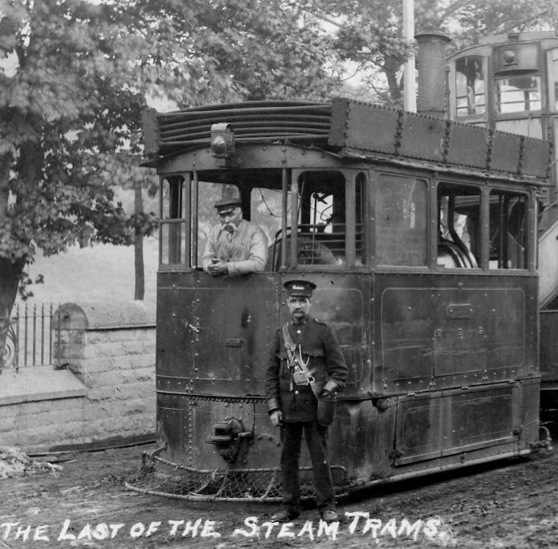
One of a number of postcard views of Rawtenstall's steam trams, which had by the date of this photograph — July 1909 — become the last vestige of this particular form of street traction in England. The conductor is wearing the standard Rawtenstall uniform issued to conductors working the new electric services. The steam-tram driver is possibly Brian Coll (snr). Photo courtesy of the Tramways and Light Railway Society.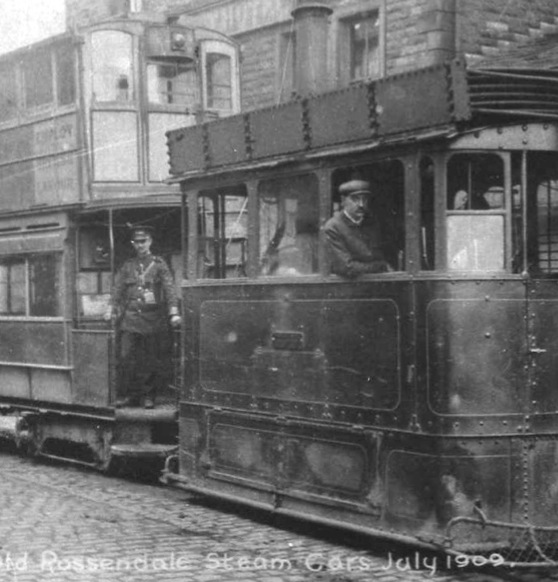
Another "Last of…" photo, purportedly taken in July 1909. As in the previous photograph, the conductor is wearing a single-breasted jacket and tensioned-crown peaked cap, the latter bearing a nickel, script-lettering grade badge. Photo courtesy of the Tramways and Light Railway Society.
Motormen and conductors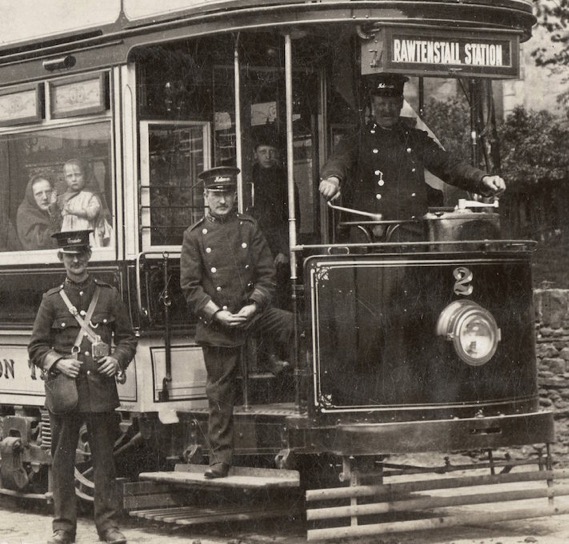
Two motormen and a conductor pose for the cameraman with what is evidently a brand-new Tramcar No 2 — photo undated, but almost certainly taken in 1909. Both motormen are wearing lancer-style tunics, the conductor a single-breasted jacket. With thanks to the Richard Rosa Collection.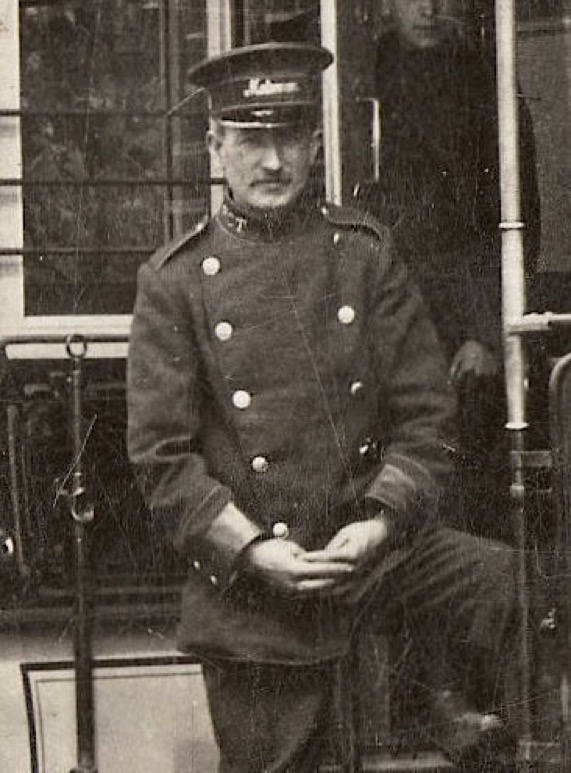
An enlargement of the above photograph showing one of the motormen. His right-hand collar bears individual 'R C T' system initials, and his piped cap a standard, off-the-shelf, script-lettering grade badge: 'Motorman'.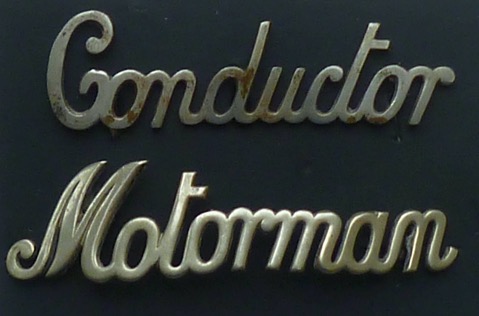
Standard off-the-shelf, script-lettering grade badges of the type initially worn by RCT tramcar crews — nickel. Author's Collection.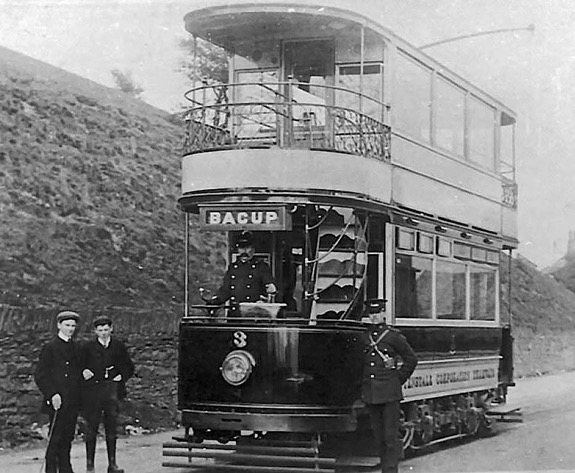
Motorman (Albert Incles) and his conductor posing with what is evidently a brand-new Tramcar No 3. The photograph was taken at Lamb Row, Lockgate, very probably on the first day of electric operation (15th May 1909); there is clearly damage to the dash of the otherwise immaculate vehicle, and this tram — driven by Albert Incles — is known to have been involved in a collision with a greengrocer’s van in Rawtenstall on that day. The line to Bacup was not actually opened until some two months after this photo was taken, and in any case, the tram is facing the wrong way; the explanation for this is that the shot was more than likely specially posed at the request of the photographer, so that he would be well-placed to sell postcards when the Bacup line eventually opened! With thanks to Richard Hargreaves for the background information, and to Duncan Holden for the photograph.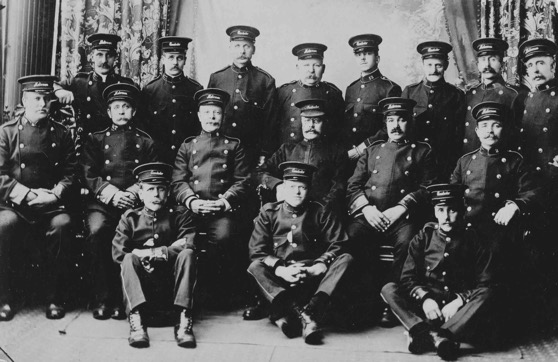
Rawtenstall Corporation Tramways staff photograph — 1909. Both the motormen and the conductors are wearing script-lettering grade badges on their caps, either 'Motorman' or 'Conductor'. Author's Collection.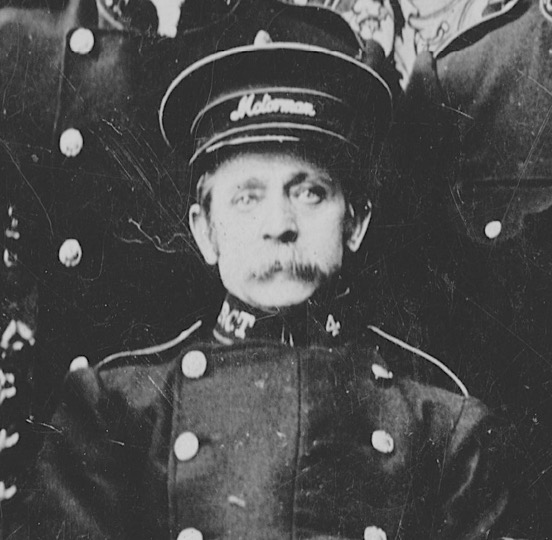
An enlargement of the above photograph (showing Motorman No 4) revealing the individual ‘R C T’ metal letters on the bearer's right-hand collar and an employee number on the left.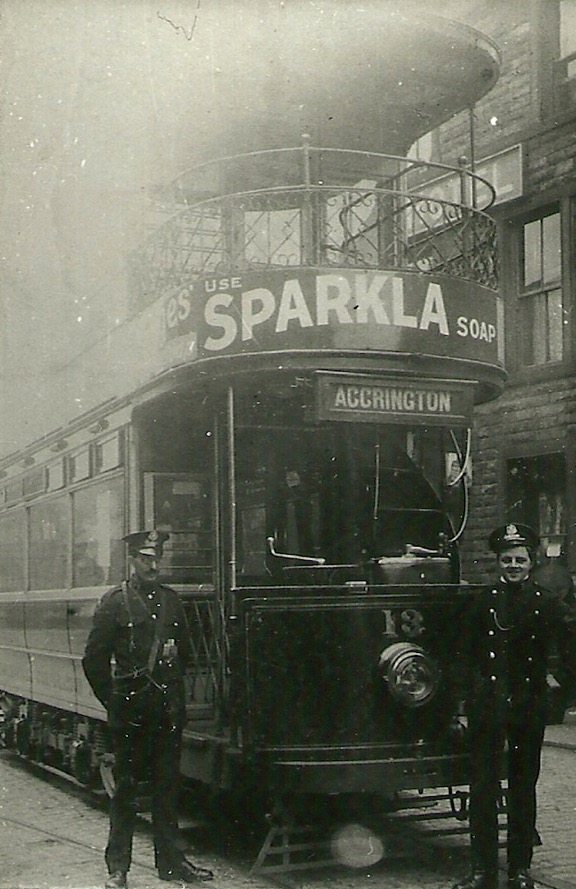
Conductor De'ath and Motorman Wallwork pose with Tramcar No 13 on a service bound for Accrington — photo undated, but given its excellent condition, probably taken not long after delivery of this car and instigation of through running (1st April 1910). Both men are wearing the new elaborate municipal cap badge (see below), with a script-lettering grade badge underneath. Photo courtesy of the Stephen Howarth Collection.
Rawtenstall Corporation Tramways cap badge — nickel. Author's Collection.
A staff photograph, this time probably the entire department, assembled at Whittaker Park — undated, but probably taken in 1911 or 1912. Photo courtesy of the Peter Fisher Collection.
An enlargement of the above photograph showing some of the conductors and motormen, whose caps clearly bear the new Rawtenstall Corporation Tramways cap badge.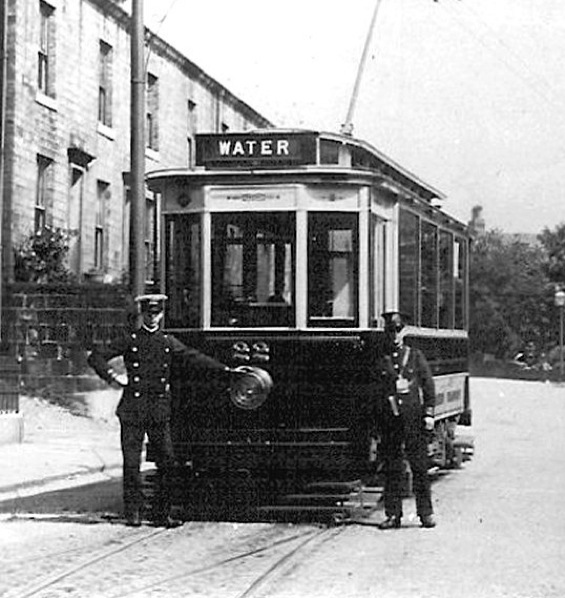
The crew of Tramcar No 22 pose for the cameraman near the terminus at Water — photo undated, but probably taken shortly after the vehicle was delivered in 1912. Photo courtesy of Duncan Holden.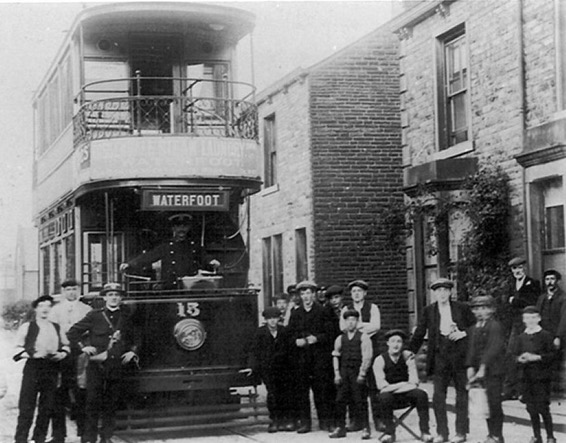
Another photograph taken near the terminus at Water, this time of Tramcar No 15 and its crew — photo undated, but probably taken around the time of the Great War. Photo courtesy of the Tramways and Light Railway Society, with thanks to David Voice.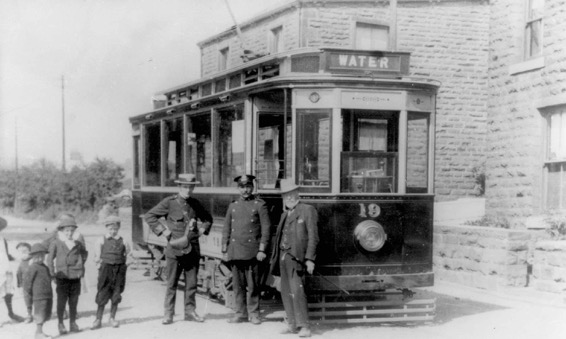
A conductor and a motorman posing with Tramcar No 19 at Lumb Baptist on the Waterfoot to Water section — photo undated, but probably taken shortly before the Great War. This vehicle was one of a batch of six delivered in 1912, which were primarily intended to work the steeply graded route to Water. Author's Collection.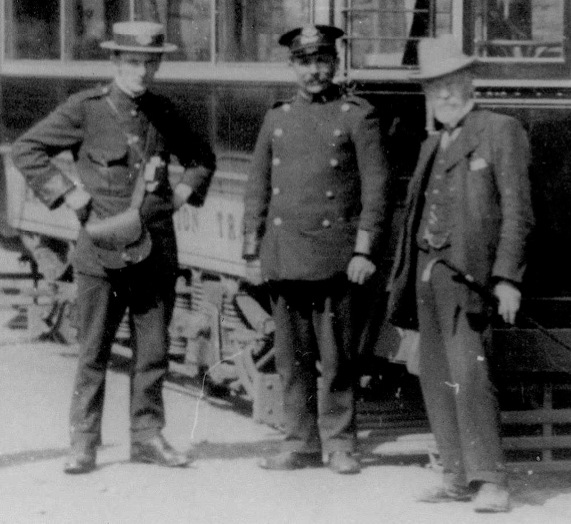
An enlargement of the above photograph showing the conductor and the motorman. The latter is wearing the new municipal cap badge, along with a 'Driver' script-lettering grade badge, rather than the usual 'Motorman'. The conductor, who is wearing a straw boater, may well be the same individual seen wearing one in the previous photograph.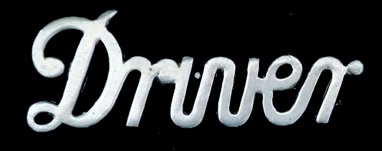
Script-lettering 'Driver' cap badge — nickel. These badges appear to have replaced their 'Motorman' counterparts within a few years of opening. Author's Collection.
The crew of Tramcar No 9, destined for Bacup, pose for the cameraman — photo undated, but judging by the relatively good condition of the tram, probably taken shortly before the Great War.
An enlargement of the above photograph showing the conductor, in his single-breasted jacket, and the motorman in his double-breasted, lancer-style jacket.
Motorman Tom Wright (Employee No 22), who had also worked as a steam-tram driver, and who retired in 1932. Photo courtesy of the Peter Fisher Collection.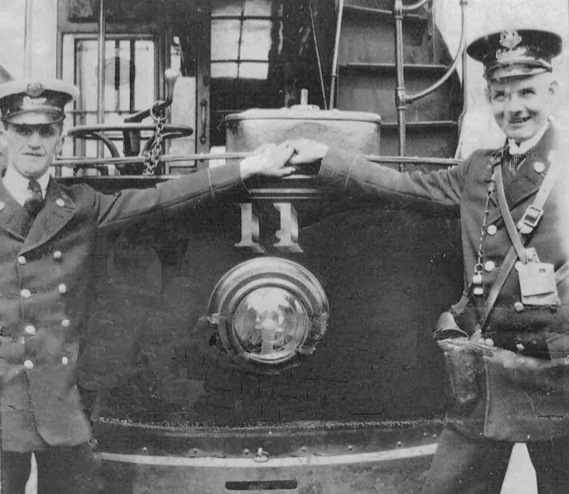
A driver and a conductor posing with Tramcar No 11 — photo undated, but probably taken in Queens Square, Rawtenstall to mark the closure of the system in April 1932. Both men are wearing double-breasted jackets with lapels. With thanks to Richard Hargreaves.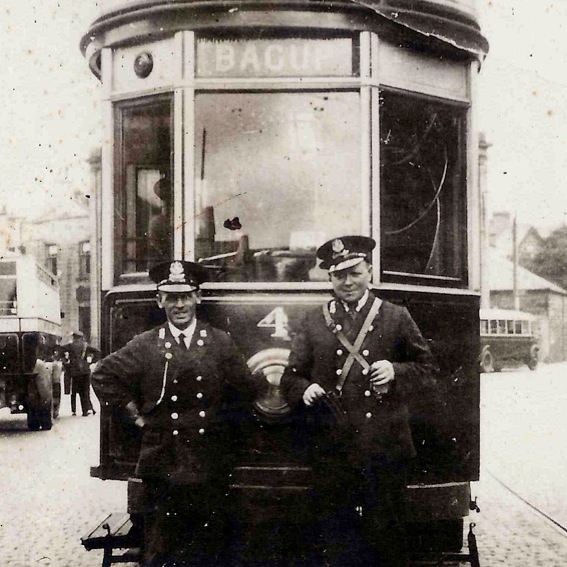
Driver Sam Doran and Conductor Jack Wallwork pose with Tramcar No 4 — photo undated, but probably taken in Queens Square, Rawtenstall to mark the closure of the system in April 1932. The photo was definitely taken no earlier than 1931 as there is a bus in the background (Fleet No 33; not shown), which was only delivered in that year. With thanks to Richard Hargreaves.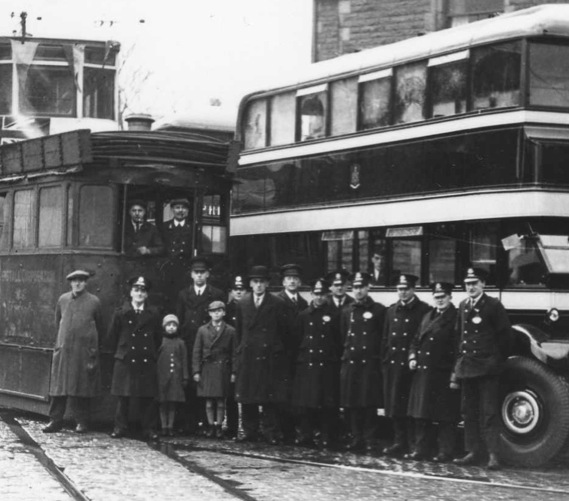
A line-up of Rawtenstall Corporation staff, some undoubtedly bus men, taken at the parade to mark the closure of the system on the 7th April 1932. The two men in the steam tram are the driver, Albert Incles, and Alfred Bennion. From left to right, standing, are tentatively identified as: Thomas Goldsmith, Frank ?, Inspector E Duddington, Driver L Clegg, Depot Superintendent A Cooper, Inspector W Harker, and A Bolton; the rest are unknown. Photo courtesy of the Tramways and Light Railway Society.
Senior staff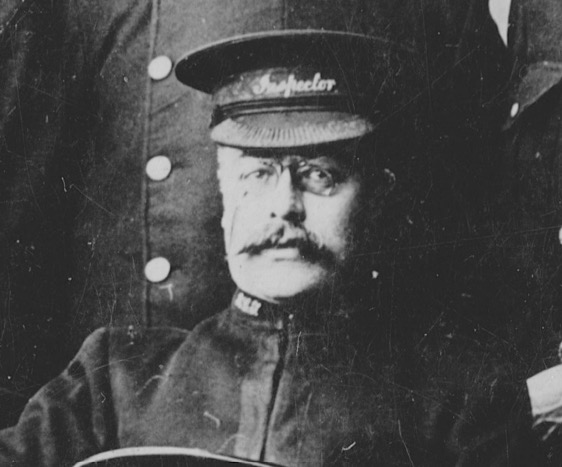
An enlargement of the 1909 staff photograph above showing the inspector — his script-lettering grade badge is embroidered on a brocade-style hat band.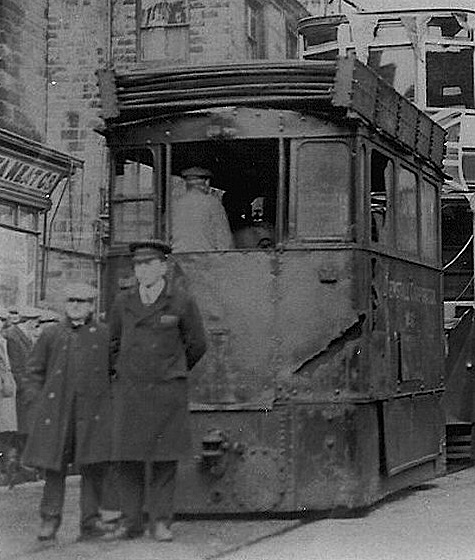
An inspector (believed to be Mr E. Duddington) stands before the steam tram used in the last-day parade at Rawtenstall. Photo courtesy of the Tramways and Light Railway Society.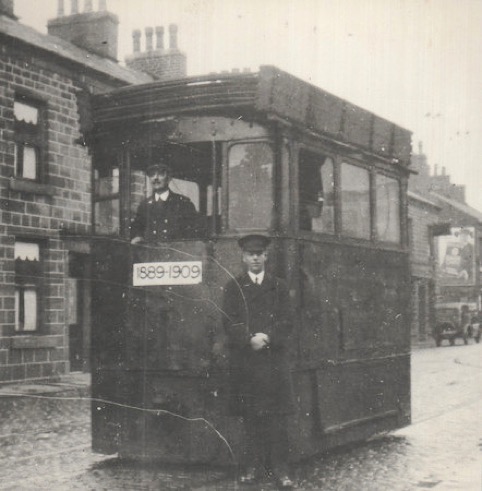
Another last-day shot showing an inspector on Bacup Road near Rawtenstall Town Hall, just outside the depot. Photo courtesy of the Tramways and Light Railway Society.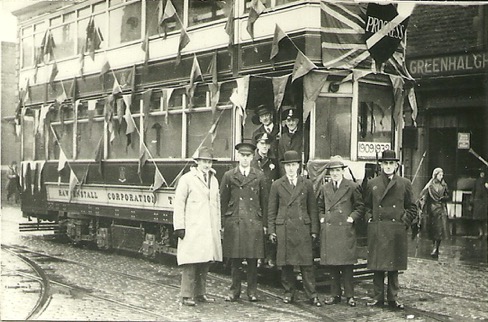
…and yet another taken at the closure parade. Stephen Howarth Collection.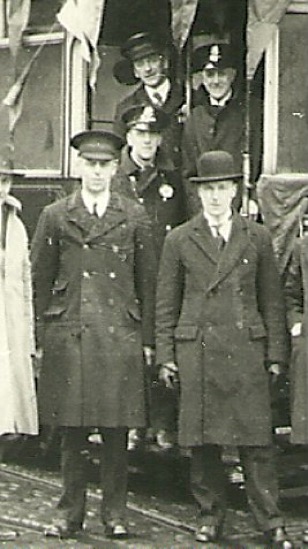
An enlargement of the above photograph showing the inspector, who is probably Mr E. Duddington.
Female staff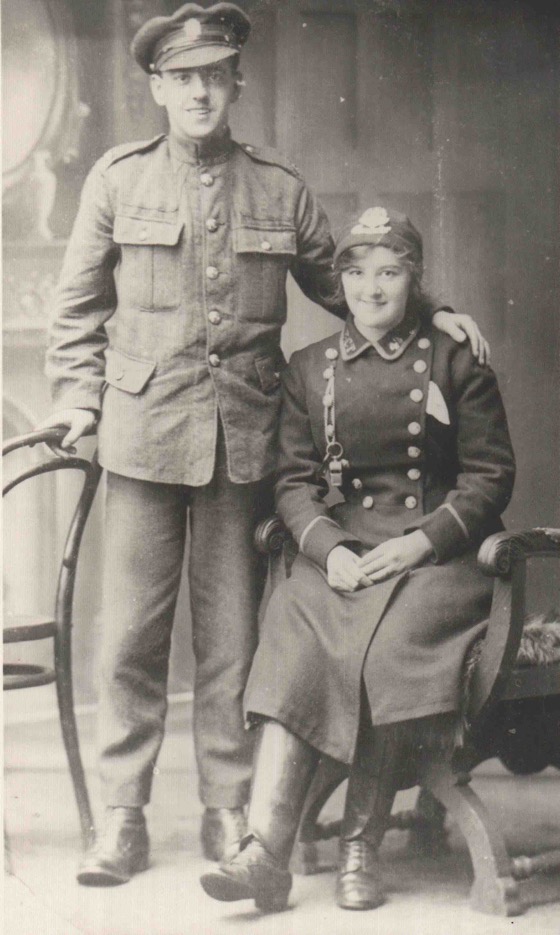
A Great War Rawtenstall Corporation Tramways conductress and a soldier, more than likely her brother or fiancé. Photo courtesy of the Peter Fisher Collection.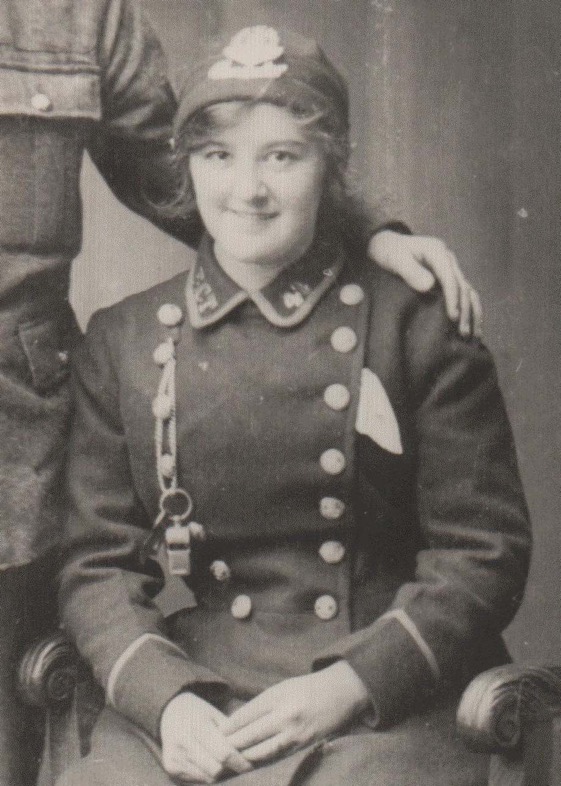
An enlargement of the above photograph revealing her to be Employee No 42. She is wearing a brand-new uniform and what would appear to a brimless cloth bonnet, not unlike a modern beanie; it bears the standard RCT cap badge and a script-lettering grade badge. This style of hat was also used by the corporation systems of Manchester and Salford (amongst a few others) and was presumably for winter wear.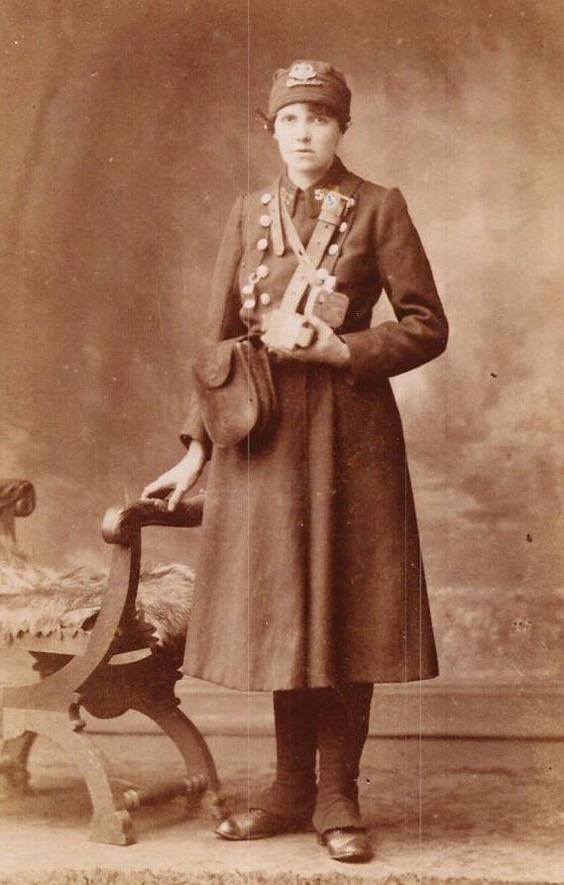
Great War RCT conductress Frances Dust (née Holden). Photo courtesy of Sharon Wood, her great grand-daughter, with thanks to Peter Fisher.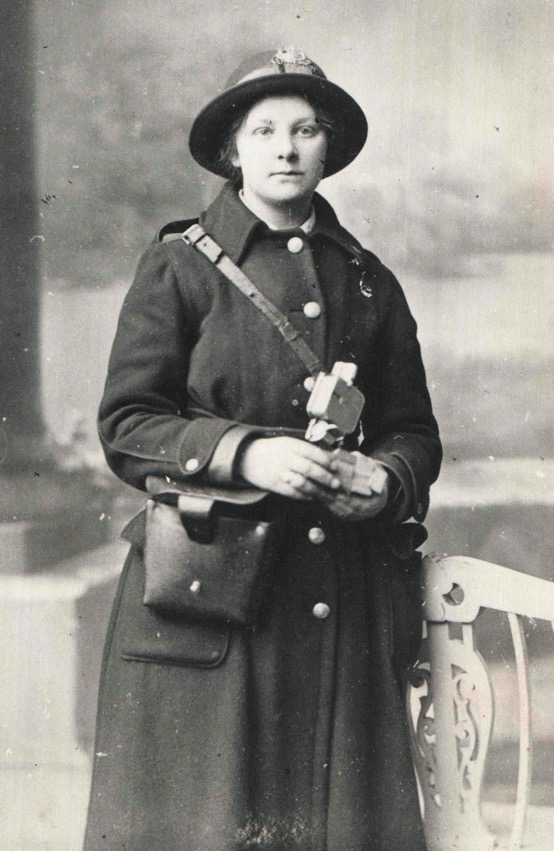
A Great War Rawtenstall Corporation Tramways conductress. The subject is wearing a single-breasted greatcoat and a dark-coloured felt bonnet, the latter presumably for summer wear. Photo courtesy of Duncan Holden.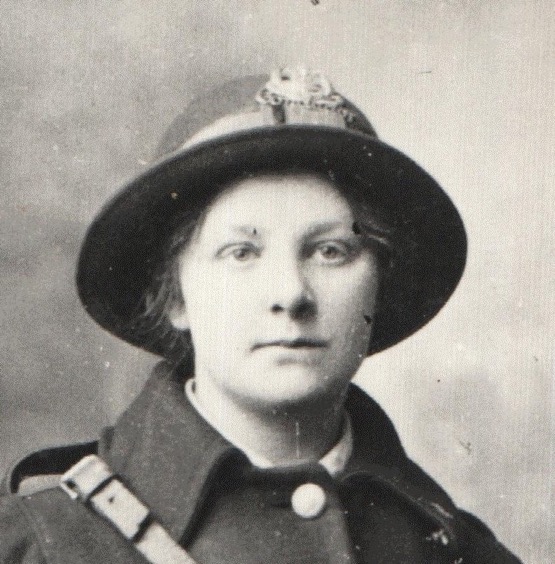
An enlargement of the above photograph showing details of the bonnet, which carries a script-lettering 'Conductor' grade badge and the standard 'RCT' cap badge.